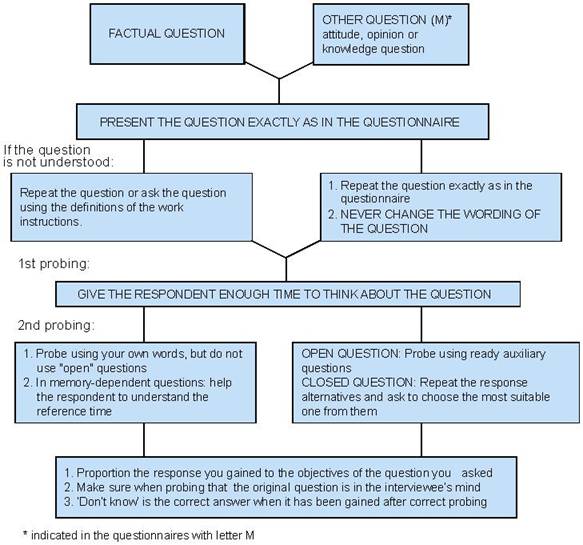Illness - a fact or an experience?
- Two types of information
- A factual question also requires interpretation and assessment
- "It just didn't occur to me"
- "It is not any real illness"
- Factual information – is it really available?
Koko dokumentti yhdell� sivulla
Kaisa-Mari Okkonen, the writer works as Senior Statistician at the Social Statistics department of Statistics Finland.
Health is an experiential state, which, when studied with survey methods, requires sensitivity to the effects of the measurement methods and the context of asking. Pre-testing related to questionnaire and question design helps to understand the nature of knowledge and to make interpretations of this multidimensional phenomenon.
DESIGNING OF A DATA COLLECTION FORM is a complex where the objectives of measurement and the practices of interview interaction must be reconciled. This is often not easy, because from the viewpoint of measurement, good and precise question formulations do not necessarily work well in an interview situation, and on the other hand, question design only on the terms of interaction weakens the quality and comparability of the responses obtained.
In planning Statistics Finland's surveys this tension is managed by means of questionnaire standards. The aim of the questionnaire standards is to make the data collection situation as controlled as possible as regards its measurement objectives in order to retain the validity of measurement (e.g. Houtkoop-Steenstra 2000). They also help to make the work of an interviewer easier by giving enough information about the purpose of questions and the means used to receive answers. Questionnaire standards are thus also interview standards.
In Statistics Finland's standards for interview questionnaires the questions are divided into factual questions and opinion, attitude and knowledge questions (so-called M questions). Factual questions are thought to be of factual nature, while the latter contain both subjective views and assessments and questions measuring the person's knowledge level. Presenting these questions in interview situations is guided by various principles.
The borderline between fact and subjective information is not, however, always clear. This observation was made when in autumn 2010 we were pre-testing at Statistics Finland's Cognitive Laboratory the ad hoc question module implemented in connection with the Labour Force Survey of Eurostat, the Statistical Office of the European Communities concerning health and capacity to function. The module examines the respondent's long-term illnesses, activity limitations and their effects on the capacity to function and work.
Two types of information
The practical difference in interview situations between factual questions and so-called M questions separated in Statistics Finland's questionnaire standards is that various ways of probing can be used more freely in presenting factual questions, while in M questions it is defined more strictly beforehand what kind of probing can be used. (Figure 1.) Questionnaire standards are subject to agreement, and statistical agencies and research institutes in different countries use different variations on the degrees of interview standardisation and interviewer autonomy (e.g. Viterna—Maynard 2002).
Figure 1. Instructions on presenting question forms and probing.

Source: Design standards of interview questionnaires 2001. Statistics Finland.
The definition of question type is connected to the content and has to be made by the researcher designing the questionnaire. The question type cannot be inferred from the outward appearance of the question: externally the same question can be directed, depending on the objective, to collection of factual information or to testing of the respondent's knowledge level, for instance (Design standards of interview questionnaires 2001). Defining the type of question thus depends on the aim of the question, and it is indicated in the questionnaire by marking M questions with red letter M. The other questions are by default factual questions.
Alkuun Edellinen Seuraava
Last updated 26.9.2011
